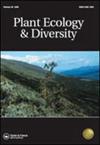Ecology and management of invasive plants in the sub-Antarctic and Antarctic regions: evidence and synthesis from Macquarie Island
IF 1.6
4区 生物学
Q2 PLANT SCIENCES
引用次数: 1
Abstract
ABSTRACT Background The Antarctic is an extreme environment for plants. Several invasive plant species, however, have invaded the sub-Antarctic Southern Ocean islands and increasingly threaten the vulnerability of maritime and continental Antarctica, particularly with changes in climate. Aims We provide an overview of issues to consider with regard to the impact, ecology and management of non-native plants in the Antarctic, focusing on knowledge gained and recent research results from the sub-Antarctic with possible application to Antarctica. Methods We provide a brief review of literature and bring together experience and previously unpublished research with Poa annua and Stellaria media on Macquarie Island. Results While no one set of biological characteristics predicts plant invasiveness in the sub-Antarctic, all are adapted to survive extreme cold conditions and persistence is enabled through large and long-lived soil seed banks. Ecological drivers for invasion include accidental human introductions and continuing movement, along with animal and other disturbance to soil. Conclusion The invasive cold-tolerant plant species now prevalent on sub-Antarctic islands also pose a threat to Antarctica due to a warming climate and so efforts should continue to prevent further spread, while developing effective, low-impact control and eradication options to protect these high-value extreme ecosystems.亚南极和南极地区入侵植物的生态学和管理:来自麦考瑞岛的证据和综合
摘要背景南极对植物来说是一个极端的环境。然而,一些入侵植物物种已经入侵了亚南极南大洋岛屿,并日益威胁到南极洲海洋和大陆的脆弱性,特别是随着气候的变化。目的我们概述了在南极非本土植物的影响、生态学和管理方面需要考虑的问题,重点介绍了从亚南极获得的知识和最近的研究结果,并可能应用于南极洲。方法我们对文献进行了简要回顾,并结合了麦格理岛Poa annua和Stellaria媒体的经验和以前未发表的研究。结果虽然没有一组生物学特征可以预测亚南极地区的植物入侵性,但所有这些特征都能适应极端寒冷的条件,并且通过大型和长寿命的土壤种子库实现了持久性。入侵的生态驱动因素包括人类的意外引入和持续运动,以及动物和其他对土壤的干扰。结论由于气候变暖,目前在亚南极岛屿上流行的耐寒入侵植物物种也对南极洲构成了威胁,因此应继续努力防止进一步传播,同时制定有效、低影响的控制和根除方案,以保护这些高价值的极端生态系统。
本文章由计算机程序翻译,如有差异,请以英文原文为准。
求助全文
约1分钟内获得全文
求助全文
来源期刊

Plant Ecology & Diversity
PLANT SCIENCES-
CiteScore
3.30
自引率
0.00%
发文量
26
审稿时长
3 months
期刊介绍:
Plant Ecology and Diversity is an international journal for communicating results and novel ideas in plant science, in print and on-line, six times a year. All areas of plant biology relating to ecology, evolution and diversity are of interest, including those which explicitly deal with today''s highly topical themes, such as biodiversity, conservation and global change. We consider submissions that address fundamental questions which are pertinent to contemporary plant science. Articles concerning extreme environments world-wide are particularly welcome.
Plant Ecology and Diversity considers for publication original research articles, short communications, reviews, and scientific correspondence that explore thought-provoking ideas.
To aid redressing ‘publication bias’ the journal is unique in reporting, in the form of short communications, ‘negative results’ and ‘repeat experiments’ that test ecological theories experimentally, in theoretically flawless and methodologically sound papers. Research reviews and method papers, are also encouraged.
Plant Ecology & Diversity publishes high-quality and topical research that demonstrates solid scholarship. As such, the journal does not publish purely descriptive papers. Submissions are required to focus on research topics that are broad in their scope and thus provide new insights and contribute to theory. The original research should address clear hypotheses that test theory or questions and offer new insights on topics of interest to an international readership.
 求助内容:
求助内容: 应助结果提醒方式:
应助结果提醒方式:


